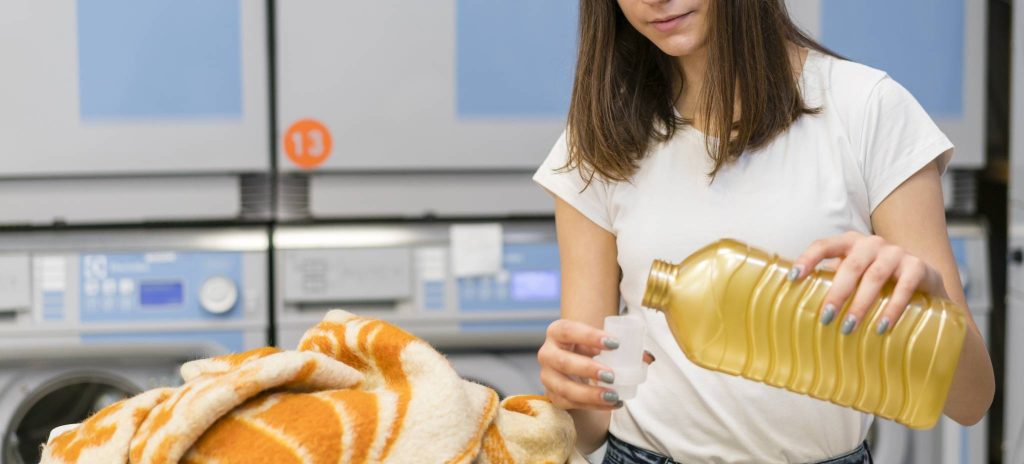Free Shipping Over £75 Orders
- 100% RECYCLEABLE PACKAGING HERBAL AND ORGANIC INGREDIENTS
Free Shipping Over £75 Orders
- 100% RECYCLEABLE PACKAGING HERBAL AND ORGANIC INGREDIENTS

Love it or hate it, fabric conditioners are a big part of washing routines for many people. Fabric conditioner is a product of many uses: From the conventional use of softening and scenting your laundry to more unconventional tasks such as unshrinking sweaters, removing wallpaper, or dusting baseboards. Its effectiveness and cost-efficiency make it a proven multitasker. However, like its counterparts like laundry liquids and washing up liquids, there are also do’s and don’ts with fabric conditioner.
First, let’s define fabric conditioner. What is it exactly? Is fabric conditioner fabric softener? Fabric conditioner and fabric softener are essentially the same term for a product that protects the fibres of your clothing while enhancing their appearance, scent, and texture, leaving them looking, smelling, and feeling fantastic. Now, let’s look into do’s and don’ts of fabric conditioners:

It is crucial to look into the guidelines provided by the manufacturer when adding fabric conditioner into your laundry routine. By following these recommendations, you ensure optimal results and proper care for your garments. The manufacturer’s guidelines often include specific instructions on dosage, application methods, and compatibility with different fabrics. This not only enhances the effectiveness of the fabric conditioner but also contributes to the longevity and quality maintenance of your clothing. Whether it’s regarding fabric conditioner, specific fabric types, or recommended usage for various settings, staying true to the manufacturer’s instructions is key to achieving the best outcomes in your laundry routine.

Consider incorporating eco-friendly options like Just Green Organic Herbal Fabric Softener into your laundry routine for both environmental benefits and effective results. Our fabric conditioner not only provides natural softness to your clothes but does so without leaving any residue. Its allergen-free formulation ensures extra softness and delicate care, making it suitable for use on coloured and white garments, including baby laundry. Relaxing lavender oil in its natural formula leaves a refreshing scent on your laundry.
Designed for sensitive skin, shake the bottle, and add the hypoallergenic fabric softener to the washing machine drawer or rinse water at the cycle’s end—avoid direct pouring onto clothing. Packaged in 100% recyclable materials, this eco fabric conditioner emphasizes sustainability. Store upright in a cool place, away from sunlight. With one bottle providing 32 washes, you contribute to a cleaner and healthier environment with every use.

A very important factor to consider when using fabric conditioner is to never overuse it. You may have heard the saying a little goes a long way. Well, it’s also true for fabric conditioner. Though recent fabric softeners are less likely to cause build ups, it is crucial to adhere to the dosage directions provided, as excessive use may still result in product accumulation on your products. Extreme overuse could potentially lead to residues accumulating and forming a coating on the washing machine components, potentially causing clogs. It is therefore very important to ensure a balanced use to benefit from conditioners.

Fabric softeners are highly effective on compatible fabrics, but their optimal performance is achieved when they are diluted in water during the rinse cycle. Pouring fabric softener directly on clothes is not advisable, as it can lead to stains and hinder thorough cleaning. The recommended methods for adding fabric softener to a load are either using the fabric softener dispenser or manually incorporating it during the rinse cycle after the drum is filled with water. This ensures proper dispersion and absorption, enhancing the softening effects without compromising the cleanliness of your products.
Fabric conditioner and detergent should not be mixed during the laundry process. The chemical reaction between the two can render one or both of them ineffective. Instead, use them separately in your washing machine. This ensures that both products can function effectively, providing the best cleaning outcome for your laundry. Remember to put your laundry into the machine without exceeding the inner tube level for efficient washing.
Is it crucial to know that fabric conditioner can cause harm to certain fabrics? What kind of fabrics are these? Well, for the best outcome, avoid using fabric softener on delicate fabrics like cashmere and wool, as it can lead to damage such as bobbling, fibre wear-down, and pilling, compromising the feel of these high-quality materials. A general rule is to refrain from using fabric softener on expensive clothing items. For optimal care, read your product’s label guides, wash inside out, use a gentle natural detergent, and avoid enzyme-based detergents that can harm wool protein. Similarly, for towels, fabric softener diminishes absorbency, wears down fibres, and imparts a slippery, greasy feel. Instead, maintain softness by adding 20ml of white vinegar directly to the wash for a natural alternative that softens towels and eliminates bacteria without synthetic chemicals. This advice is also applicable for microfiber cloths.
Additionally, if you have sensitive skin, be cautious with fabric softeners, as they may cause skin reactions. However, this is not the case with Just Green’s fabric conditioner, as our products are hypoallergenic, sensitive skin and eczema friendly! With many certificates, our vegan non-bio products are perfect for you, your baby, pets, household plants and your loved ones! Still, we recommend you test your products to prevent any further problems. If you have any questions, feel free to contact us!
Stay Informed About Us!



Main Menu
Cookies
We use cookies to personalise content and ads, to provide social media features and to analyse our traffic. We also share information about your use of our site with our social media, advertising and analytics partners who may combine it with other information that you’ve provided to them or that they’ve collected from your use of their services.